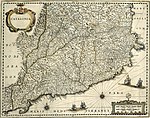
Back كتالونيا عبر التاريخ Arabic Història de Catalunya Catalan مێژووی کەتەلۆنیا CKB Cataloniens historie Danish Geschichte Kataloniens German Ιστορία της Καταλονίας Greek Historia de Cataluña Spanish Kataluniako historia Basque Histoire de la Catalogne French Historia de Cataluña Galician
| History of Catalonia |
|---|
 |
| Timeline |
| Catalan / Valencian cultural domain |
|---|
 |
The recorded history of the lands of what today is known as Catalonia begins with the development of the Iberian peoples while several Greek colonies were established on the coast before the Roman conquest. It was the first area of Hispania conquered by the Romans. It then came under Visigothic rule after the collapse of the western part of the Roman Empire. In 718, the area was occupied by the Umayyad Caliphate and became a part of Muslim ruled al-Andalus. The Frankish Empire conquered northern half of the area from the Muslims, ending with the conquest of Barcelona in 801, as part of the creation of a larger buffer zone of Christian counties against Islamic rule historiographically known as the Marca Hispanica. In the 10th century the County of Barcelona became progressively independent from Frankish rule.[1][2]
In 1137, Ramon Berenguer IV, Count of Barcelona betrothed the heiress of the Kingdom of Aragon, Petronilla, establishing the dynastic union of the County of Barcelona with Aragon, resulting in a composite monarchy later known as Crown of Aragon, while the County of Barcelona and the other Catalan counties merged into a state, the Principality of Catalonia,[3] which developed an institutional system (Catalan Courts, constitutions, Generalitat) that limited the power of the kings. Catalonia sponsored and contributed to the expansion of the Crown's trade and military, most significantly their navy. The Catalan language flourished and expanded as more territories were added to the Crown of Aragon, including Valencia, the Balearic Islands, Sardinia, Sicily, Naples, and Athens. The Crisis of the Late Middle Ages, the end of the reign of House of Barcelona, serf and urban conflicts and a civil war (1462–1472) weakened the role of the Principality within the Crown and internationally.
The marriage of Ferdinand II of Aragon and Isabella I of Castile in 1469 created a dynastic union between the Crowns of Aragon and Castile, and both realms kept their own laws, institutions, borders and currency.[4] In 1492 the Spanish colonization of the Americas began, political power began to shift away towards Castile. Tensions between Catalan institutions and the Monarchy, alongside the economic crisis and the peasants' revolts, caused the Reapers' War (1640–1652), being briefly proclaimed a Catalan Republic. By the Treaty of the Pyrenees (1659), the northern parts of Catalonia, mostly the Roussillon, were ceded to France. The status of separate state of the Principality of Catalonia came to an end after the War of Spanish Succession (1701–1714), in which the Crown of Aragon supported the claim of the Archduke Charles of Habsburg. Following Catalan surrender on 11 September 1714, the king Philip V of Bourbon, inspired by the model of France imposed a unifying administration across Spain, enacting the Nueva Planta decrees, which suppressed the main Catalan political institutions and public law, and merged it into Castile as a province. These led to the eclipse of Catalan as a language of government and literature. During the second half of the 17th and the 18th centuries Catalonia experienced economic growth, reinforced in the late 18th century when Cádiz's trade monopoly with American colonies ended.
In the 19th century Catalonia was severely affected by the Napoleonic and Carlist Wars. The Napoleonic occupation and subsequent war in Spain began a period of political and economic turmoil. In the second third of the century, Catalonia became a center of industrialization. As wealth from the industrial expansion grew, Catalonia saw a cultural renaissance coupled with incipient nationalism while several workers movements (particularly anarchism) appeared.
In the 20th century, Catalonia enjoyed and lost varying degrees of autonomy. The Second Spanish Republic (1931–1939) established Catalan self-government and the official use of the Catalan language. Like much of Spain, Catalonia (which, in turn, expererienced a revolutionary process) fought to defend the Republic in the Civil War of 1936–1939. The Republican defeat established the dictatorship of Francisco Franco, which unleashed a harsh repression and suppressed the autonomy. With Spain devastated and cut off from international trade and the autarkic politics of the regime, Catalonia, as an industrial center, suffered severely; the economic recovery was slow. Between 1959 and 1974 Spain experienced the second-fastest economic expansion in the world known as the Spanish Miracle, and Catalonia prospered as Spain's most important industrial and tourist area. In 1975 Franco died, bringing his regime to an end, and the new democratic Spanish constitution of 1978 recognised Catalonia's autonomy and language. It regained considerable self-government in internal affairs and today remains one of the most economically dynamic communities of Spain. Since the 2010s there have been growing calls for Catalan independence.
- ^ Salrach 2004, pp. 144–149.
- ^ Saez, Anna; Garrido, David (27 September 2019). "El dia que Borrell II 'es va independitzar' dels francs". Sàpiens. Retrieved 8 November 2019.
- ^ Sesma Muñoz, José Angel. La Corona de Aragón. Una introducción crítica. Zaragoza: Caja de la Inmaculada, 2000 (Colección Mariano de Pano y Ruata - Dir. Guillermo Fatás Cabeza). ISBN 84-95306-80-8.
- ^ Elliott, J. H. (John) (2002). Imperial Spain 1469-1716. London: Penguin. ISBN 0141007036. OCLC 49691947.
© MMXXIII Rich X Search. We shall prevail. All rights reserved. Rich X Search